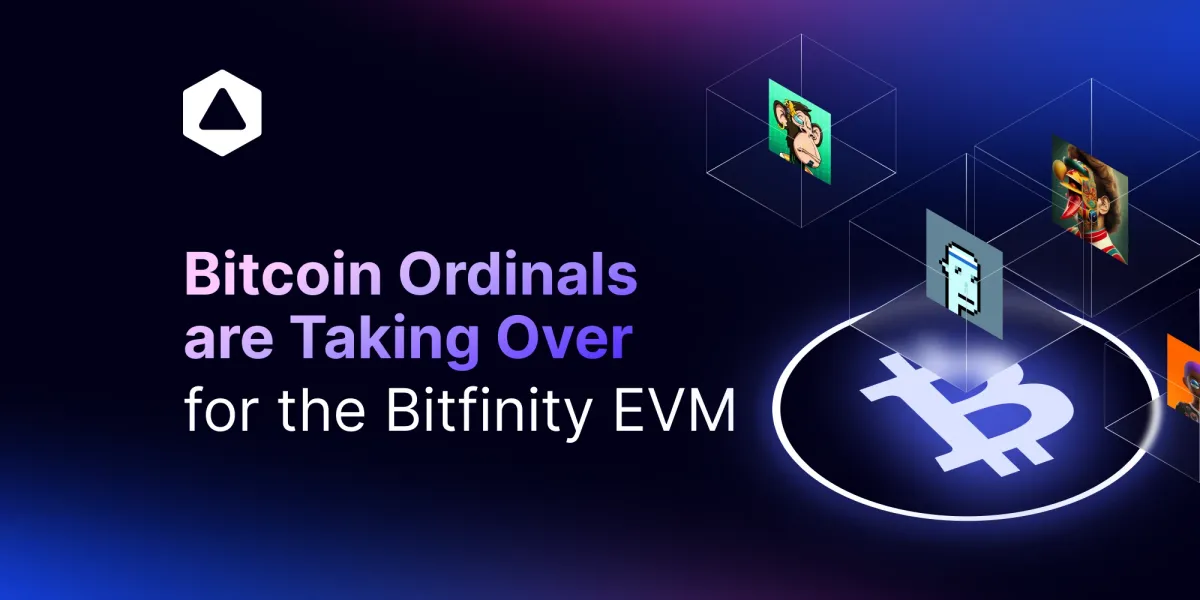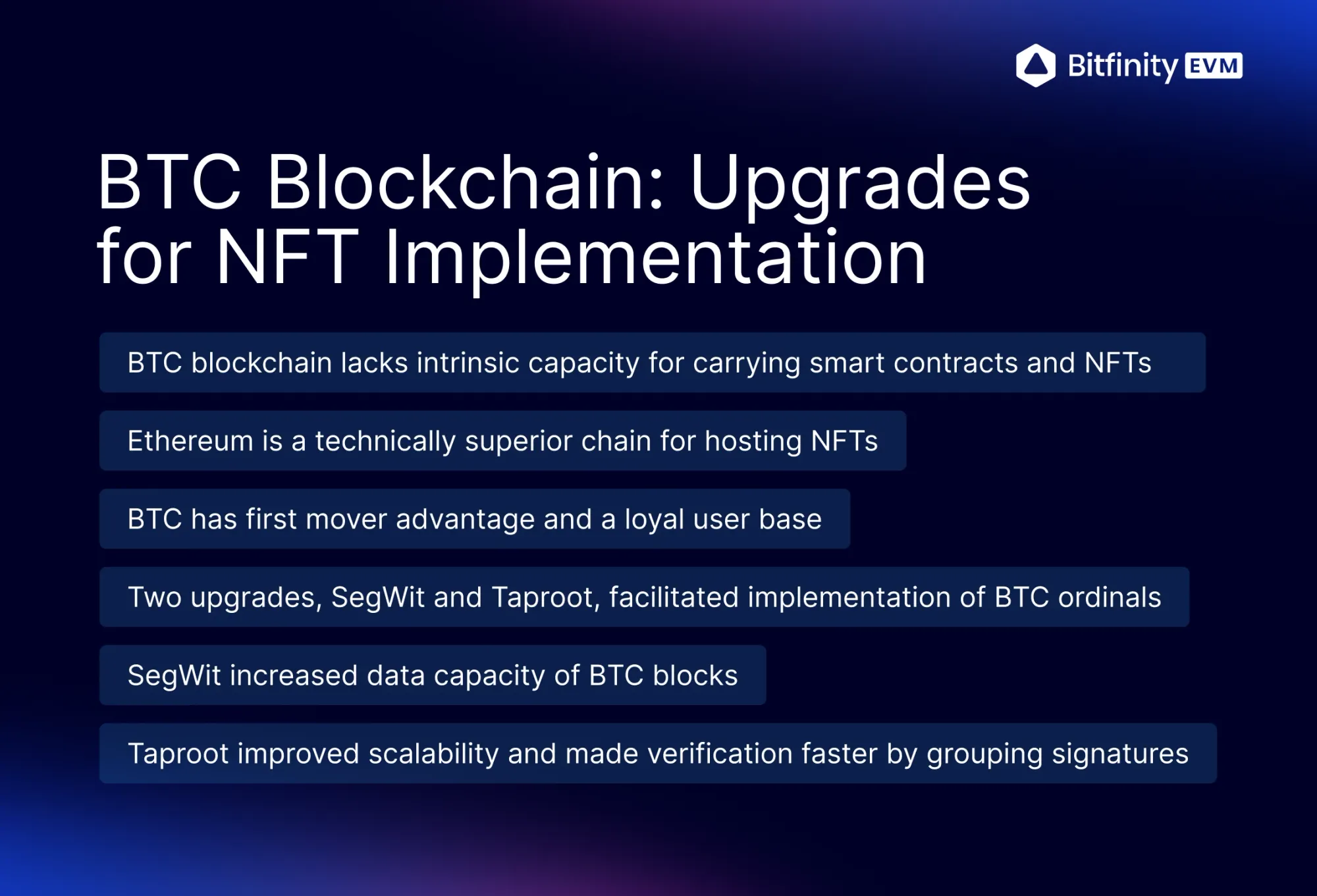Bitcoin Ordinals are Taking Over

Close to five million ordinal inscriptions have been recorded during the summer of 2023 on the BTC chain. Since the day they came out, they've been explosive. But what are Ordinals, why the ordinal craze, and why now?
What are Ordinals
A layer 2 protocol on the BTC blockchain, sometimes called a "digital artefact", Bitcoin Ordinals are a type of NFT which are taking the crypto community by storm.
Created by Casey Rodarmer, the creation of a Bitcoin Ordinal involves the inscription of an image on a particular Satoshi, of which there are 21 trillion on the BTC chain (100m Satoshis per BTC).
Facilitated by Upgrades

The BTC blockchain was not initially designed to carry such NFTs at its inception, and as such has no intrinsic capacity for carrying smart contracts. The chain has low processing power, high fees, and a small data capacity, which means that purpose built Ethereum is a far superior chain for the task of hosting NFTs in a technical sense.
What BTC does have though, is first mover advantage. A loyal and committed user base watches every move on the chain, ready to invest heavily in new technologies . This counts for an awful lot. Development on the BTC chain persists because of BTCs long established status as top dog in the crypto space.
Two upgrades to the BTC network have facilitated the implementation of BTC ordinals; SegWit and Taproot;
- The SegWit upgrade changed the way in which data is handled by the BTC blockchain, and how data is committed to blocks. The upgrade increased the amount of data that blocks can carry significantly.
- Taproot improved scalability by building on the improvements of the SegWit upgrade, and made verification faster. By grouping together multiple signatures, the metadata portion of the Ordinals inscription could then be carried by the network.
Adopted With Enthusiasm
Close to five million ordinal inscriptions have been recorded to date on the BTC chain, a staggering number given the short space of time that the protocol has been in existence. In just a few months ordinals has gone from not existing at all, to becoming a key part of the BTC network.
The beginning of the ordinal craze saw a rush to inscribe Satoshis with images, text and code, and saw a high value placed on the number of the inscription. Interestingly, this quality of inscription number has now been exploited, and inscription numbers will potentially be messed up. This is only a minor exploit of the protocol, but may leave those that paid inflated prices for ordinals with premium inscription numbers out of pocket.
As with all emerging technologies, getting in early often holds the biggest rewards, as well as the biggest risks. Speculative investing in the relatively unknown can potentially end badly.
BRC-20 Tokens have been Added on Top
Modelled after Ethereum's ERC-20 protocol, BRC-20 tokens have been developed as a method of sending fungible tokens using the ordinals protocol. They are an experimental token standard, implemented to add yet another dimension to the BTC blockchain.
The protocol was developed in march by a pseudonymous developer known as Domo. BRC-20 tokens are designed specifically for use on the BTC blockchain, however they can be bridged for use on other chains in certain circumstances.
BRC-20 tokens are deployed to the BTC blockchain by inscribing information to Satoshis in a similar manner to ordinals, in the form of a JSON file. The inscription is then read by off-chain software and is thereby tracked as a token.
There are two important differences between ERC-20 and BRC-20 tokens;
- BRC-20 tokens do not make use of smart contracts
- They require the use of a BTC wallet, rather than the required Ethereum wallet for ERC-20 tokens.
The BRC-20 market capitalization has already sky-rocketed to almost $1bn dollars, a testament to the interest that is out there for innovations on the BTC blockchain. The increase in activity brought about on chain by the introduction of BRC-20 tokens has caused transaction costs on the BTC blockchain to increase dramatically. This has generated more revenue for miners, although it has left some users a little annoyed.
Deciding whether this system is an overly convoluted example of the relatively straightforward ERC-20 token implementation available on Ethereum, is up to you.
Peak BTC Ordinal Mania
One dedicated ordinals fan and Bored Ape holder, decided to send his Ape to the burn address and to inscribe it as an ordinal on a random Satoshi.
Unsurprisingly, the move was met with widespread scepticism from the NFT community as to, well... the point of doing it.
Often it can be difficult to pinpoint peak mania but this seems to have been the exact moment that the world went crazy for BTC ordinals.
Will Ordinals Stand the Test of Time?
While Ordinals and BRC-20 tokens might make a tonne of sense to crypto enthusiasts, there is a high degree of knowledge and understanding required to even purchase them. There is a barrier to entry that is difficult to overcome even for those in the know.
Up until a few months ago, running a BTC node using Bitcoin Core was required to inscribe an ordinal, a non trivial thing to do for the storage requirements alone. The process was long and confusing and required the navigation of the Ordinal Utility and the running of various commands.
By contrast, platforms like Opensea make the NFT purchasing process much more straightforward. Having said this, platforms aiming to do the same for Ordinals such as Gamma have started appearing, aiming to make the process easier for users.
There have been many different projects formed around Ordinals technology even at this early stage. There is a high potential for innovation, and new developments happen around Ordinals technology almost daily.
It is difficult to say what the next new development in the world of Ordinals will be. One thing is for sure though, it is worthwhile keeping a close eye on BTC Ordinals and the BRC-20 token standard to see how things develop.

Connect with Bitfinity Network
Bitfinity Wallet |Bitfinity Network | Twitter | Website | Telegram | Discord | Github

*Disclaimer: While every effort is made on this website to provide accurate information, any opinions expressed or information disseminated do not necessarily reflect the views of Bitfinity itself.


Comments ()